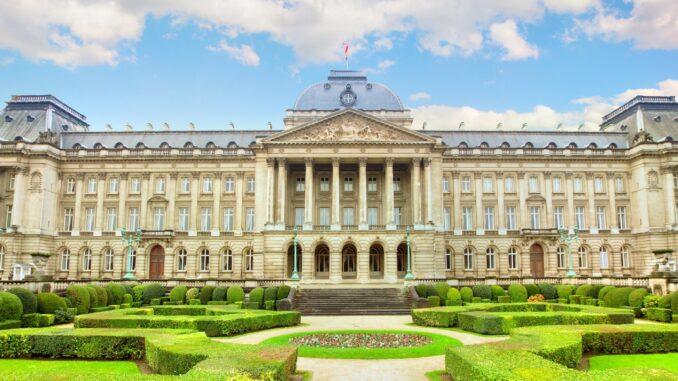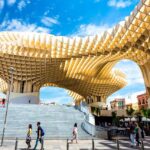
Last Updated on by Sabina
The Royal Palace of Brussels, situated in the heart of Brussels, Belgium. Is an architectural marvel that serves as the official residence of the Belgian royal family. This regal palace holds immense historical and cultural significance and showcases remarkable craftsmanship and design.

Construction of the Royal Palace commenced during the late 18th century under the reign of King Charles Alexander of Lorraine. Throughout its history, the palace has undergone several expansions and renovations, resulting in the stunning structure we see today. It represents a harmonious blend of various architectural styles. Including neoclassical and Louis XVI influences, creating a captivating and majestic appearance.
Intricate sculptures adorn the exterior of the Royal Palace, enhancing its aesthetic appeal and showcasing the craftsmanship of talented artists. Decorative friezes, and ornate columns, exuding an aura of grandeur. The palace’s entrance, guarded by ceremonial soldiers, offers a glimpse into the realm of royalty. As visitors step inside, the opulent interiors greet them with sumptuous reception rooms, gilded halls, and exquisitely furnished chambers, immersing them in a world of luxury and elegance. These spaces showcase the rich heritage and refined artistic sensibilities of the Belgian monarchy.
While the Royal Palace serves as the official residence of the Belgian king and queen. Its primary role is hosting state functions, royal ceremonies, and official receptions. Each summer, during the monarch’s annual vacation. The palace opens its doors to the public. Providing a rare opportunity for visitors to explore its magnificent rooms and admire its impressive collections of art. Furniture, and historical artifacts.
Meticulously manicured gardens envelop the Royal Palace, creating a serene and picturesque setting that enhances the palace’s beauty and offers visitors a tranquil and captivating environment.These beautifully designed gardens perfectly complement the architectural splendor of the palace. Offering a peaceful retreat amidst the bustling city center of Brussels.
As an enduring symbol of Belgium’s rich cultural heritage, the Royal Palace represents the country’s history, traditions, and monarchy. It stands as a testament to the nation’s deep-rooted respect and admiration for its royal family. The palace’s grandeur and elegance continue to mesmerize visitors. Providing them with a glimpse into the world of Belgian royalty and leaving an indelible impression of majesty and refinement.
Visiting the Royal Palace of Brussels is a remarkable experience that allows individuals to immerse themselves in the grandeur of Belgium’s monarchy and appreciate the rich legacy it represents.
Royal palace of brussels floor plan
As an AI text-based model, I’m unable to provide visual images or graphics. However, I can describe the general layout and features typically found in the Royal Palace of Brussels.
The Royal Palace of Brussels encompasses an extensive area and earns renown for its impressive architecture and luxurious interiors, captivating visitors with its grandeur and opulent design. While the specific floor plan may vary due to different sections and purposes, here is a general overview of the palace’s layout:
Grand Entrance: The palace often features a grand entrance hall, adorned with elaborate decorations, majestic staircases, and intricate ceiling designs. This entrance sets the tone for the palace’s opulence and grandeur.
State Rooms: The Royal Palace includes numerous state rooms used for official receptions, ceremonies, and diplomatic events.Fine art, ornate furnishings, and exquisite chandeliers beautifully decorate these rooms, adding an air of elegance and sophistication to their ambiance. They serve as venues for hosting dignitaries and important guests.
Throne Room: As a symbol of royal authority, the palace typically includes a grand throne room where important ceremonies and official functions take place. Lavish decorations adorn this room, which often features a prominent throne or seating area for the monarch, emphasizing their regal status and creating a focal point of majesty.
Reception Rooms: The palace houses several reception rooms, which serve as spaces for hosting guests and social gatherings. These rooms are elegantly designed and may showcase notable artworks, antique furniture, and decorative elements.
Private Apartments: Alongside the grand public spaces, the Royal Palace encompasses private apartments reserved for the royal family. These apartments include bedrooms, living areas, and private quarters where the monarch and their family reside.
Chapels: Some versions of the Royal Palace may incorporate chapels or private prayer rooms, reflecting the religious traditions and practices of the Belgian royal family.
Gardens and Grounds: Surrounding the palace, you can find expansive gardens and beautifully landscaped grounds. These outdoor spaces offer a tranquil retreat and may feature manicured lawns, ornamental gardens, and pathways for leisurely strolls.
It’s important to note that the Royal Palace of Brussels may have different sections that serve specific functions and are not accessible to the public. The actual floor plan and layout may vary based on the specific requirements and modifications made over time.
For a detailed and accurate floor plan, I recommend referring to official sources, architectural documents, or visiting the official website of the Royal Palace of Brussels, which may provide more information and visual representations.


